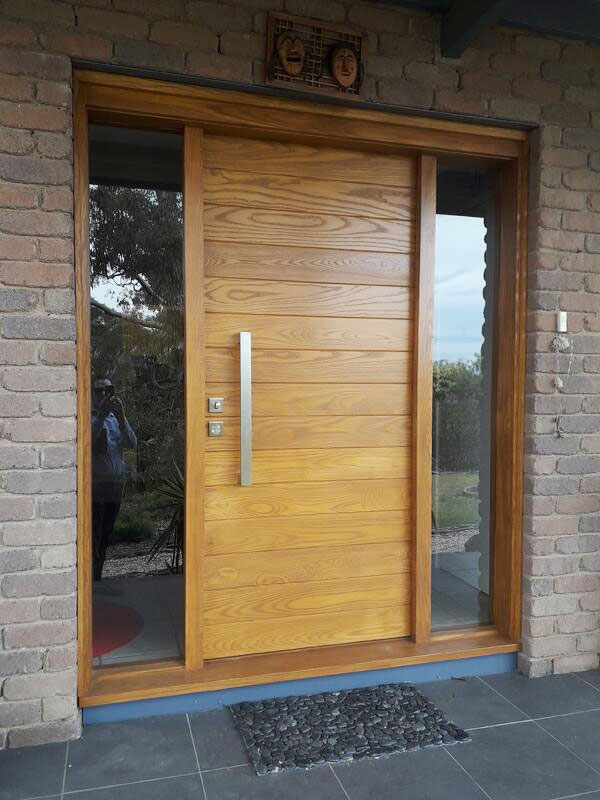HOW AND WHY TO PROTECT YOUR TRADITIONAL TIMBER DOOR
Every front door tells a story. Every groove and colour, every scuff and scratch. Even the material your door is made from is part of the tale. In New Zealand the story front doors tell is often one of a proud traditional history. Whether you live in a heritage neighbourhood where homes are kept to historical standards or you simply love the warm feel of a traditional solid timber door, we understand the love of timber and tradition. If you ever have to replace your front door, no doubt you will again choose a solid timber to remind you of our roots in the history of Australian home building.
Renovate Your Entrance: Checklist, Budget and Timeline Planner [Free Excel Template]
However, you may have also noticed that some solid timber doors last longer than others. Some doors last hundreds of years, barely seeming to have weathered over that time while other timber doors appear to nearly disintegrate in a decade or two. The difference isn’t just quality, though quality and door preparation does matter. The difference is often whether a door is exposed to the elements or sheltered.
Timber Doors and Exposed Entryways
Go ahead and think of all the timber doors you remember seeing. Which ones were holding up well, which ones were decaying? Chances are, that most of the worst-for-wear doors were in exposed entryways with very little shading or shelter from the elements. While doors that seem to last for centuries are often in recessed entryways or sheltered under a protective porch.
Once you think about it, it’s amazing just how big a difference an exposed or sheltered entryway can be. Especially with timber doors that need to be treated with respect and care. Timber, being a natural material, is susceptible to wind and weather, heat and cold, humidity and dryness with far more sensitivity than artificial material doors like aluminium or composite fibreglass.

Why Protect Your Timber Door?
So why are timber doors so important to protect? It’s because they’re made of solid natural wood that ages the same way antique furniture does. You wouldn’t leave your grandmother’s antique dresser in the sun and wind and rain. While solid timber entry doors are designed to be sturdier and more long-lived than carved furniture, the same rules apply in a basic sense. The more effectively you protect your timber door, the longer it will look good and remain strong to serve your home and family for generations to come.
This is exactly why many homes have sheltered entryways, not only do they make a home more beautiful they also serve to keep the front door in beautiful condition. An uncovered timber door deteriorates faster when left exposed in a plain, unsheltered entryway.
Here’s what an exposed entryway can do to your timber door:
Timber is Natural and Responds to the Elements
Unlike composite fibreglass or aluminium, solid timber doors are made 100% of natural wood. Cut from the solid trunk of a living tree, a timber door also has all the natural properties of well-preserved wood. When it rains, timber is designed to fill it’s cells with water which can cause swelling. Any natural factors that usually decay fallen trees in the forest will also wear down your timber door.
No matter what the natural force, your timber door’s tree-based structure has a response. It swells and shrinks, it can warp and bend, or it can rot or wear away depending on what the door is exposed to. But there’s also something warm and natural about a wood door that cannot truly be replaced or simulated with artificial materials.

Sand or Sea Spray Can Wear Away at the Surface
If you live in costal areas, there’s a good chance that the wind in your region is filled with sand, salt from sea spray, or somehow both in the same abrasive gusts. These sharp particulates wouldn’t be good for your timber door in any situation. But constant exposure to gust after gust of grainy wind and semi-corrosive sea spray can wear away at a door over the years. Wood on its own is a soft material and sand in the wind can blast away anything, including high-quality paint and sealant.
Direct Sunlight Can Make the Surface Timber Brittle and Crack
Sunshine comes with its own special risks. Almost everything about our home exteriors is designed to resist the endless bombardment of UV rays. The material and paint of your home cladding and roof is designed to resist the fading and warping of direct sunlight.
Trees are designed to soak up the sun, but only while they are still alive. I’m sure you already know what happens to a tree in nature when it falls into a sunny spot and is hit directly by sunlight most of the day. It turns white, it is leeched of moisture, and the wood grows dry and brittle over time. In nature, this helps trees disintegrate into dirt to grow more trees. But in your front door, you want to avoid the negative effects of direct sunlight on timber.
For exposed front doors, the result is usually that the top layer of wood becomes dry and brittle. On painted doors the top layer can flake off entirely or become weak and brittle to the touch. When the sun is beating on your timber door it can cause it to crack as any moisture in the door is evaporated causing the wood to shrink.

Extreme Differing Temperatures Can Cause Warping
The extreme weather we experience on either end of the calendar can also be a factor in preserving your solid timber door. In fact, doors of most materials are susceptible to damage if one side of the door is a profoundly different temperature from the other side. This can happen at either end of the calendar. In summer, extreme heat outdoors will hit a door with cool AC on the other side. In winter, the freezing cold outdoors will meet the cosy heated indoors through your front door.
This extreme temperature difference can cause your door to warp or bow toward the cold side. Sheltering your door can reduce the difference, providing protection from the hot or cold winds, shade from the heat, and cover from the snow and sleet.
Excessive Rain Can Wear or Rot a Timber Door
Unsurprisingly, rain is not good for your solid timber door. Just as dead trees in a rain-forest rot quickly, Rain has a way of pounding on a door until the porous timber soaks up the water. Wood was designed by nature to soak up water and to rot away into rich soil when a tree dies. But it can also last hundreds of years if preserved correctly.
Simply by keeping the rain off your front door, you can significantly increase the lifespan of the timber. For homes in regions that are occasionally very wet, a simple awning can prevent your door from soaking, rotting, and decaying as a result of heavy yearly rains. A raised step will keep your door from soaking in flash-floods. And a storm door can keep the rain 100% off your historical solid timber.

How to Protect Your Timber Door
If you have a home designed to expose the front door, it’s time to do some thinking. Exposed front doors are a popular feature in several building styles and some neighbourhood architects simply favour the simple lines of an exposed front door. But to protect a timber door through the ages, a little shelter can go a long way.
The good news is that you have a great many options in ways to shelter your new door.
Place the Doorway in a Recess
Many historical timber doors that have lasted the longest are subtly recessed in some beautiful stone or brickwork. Some even in garden latticework. While these details are a beautiful addition to your entryway, they also serve a practical purpose: to shelter the door. Even a simple recess keeps the rain off your door, shelters it from direct noon sunlight, and provides protection from gale force winds.
Rise the Door Above Ground-Level
A small rise before the door is another subtle and practical addition. Doors at ground-level get the bottom few inches soaked during every flash flood. It may do the job of keeping the water out of your home, but eventually flooded timber doors rot and crumble. Giving your door a step and starting the doorframe just a little off the ground can make a world of difference in protecting it from floods and torrent of water during heavy rains, and from being soaked under melting snow if your region experiences snow.

Add a Storm Door
If you want to preserve your historic wood door even more than show it off, a sturdy glass storm door might be your ideal answer. A storm door is like a screen door, but instead of letting in the lazy air of summer it blocks the biting cold even after the primary front door is opened. It also effectively creates a wind-proof shield between the elements and your timber front door.
If you are looking to protect a truly historical door, a storm door is often your best bet.
Build a Porch Around Your Entryway
Porches are natural shelters for a front door, and many lovely homes are ringed with porches where friends and family can relax in the shade. A covered porch has all the right elements to protect your timber door while leaving the door beautifully visible to visitors as they approach. If your home has a front porch but the door is exposed, a few little add-ons can look natural while building a new shelter for the door. And if you don’t yet have a porch, adding one can significantly improve both the look and enjoyment of your entryway.
Provide an Awning or Roof for the Entryway
Another solution is to build a simple shelter for the door itself. A wooden awning is a popular choice and provides your front door with just a touch of extra shade. Done correctly in the colour palette of the home, a small awning or neatly built little roof can significantly enhance an entryway. It not only protects the door, but it also gives you and guests some shelter while fumbling for keys, bringing in groceries, or waiting at the door.
Select your favourite timber door design here
Are you looking to preserve a historical timber door or replace an old entryway with a new solid timber door? If so, following these tips will help you choose the right door sheltering techniques for your home, entryway, and desired visual effect when you’re done. There are many ways to provide your traditional timber door with the protection it needs. Contact us today to find out more on how to select and care for solid timber doors.


